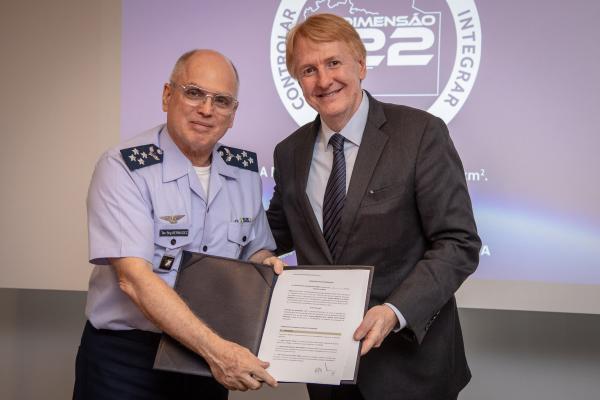
Embraer and the Brazilian Air Force (FAB) have partnered to study joint development of a light military transport with a hybrid-electric propulsion system to support passenger and cargo missions to the Amazon region and the global market, the organizations announced.
The agreement signed Dec. 19 offers a path to replace the Brazilian military’s aging C-95CM and P-95B transport and patrol aircraft derived from the EMB-110 Bandeirante, the product that launched Embraer as a company in 1969 while it was still an organization within the FAB.
The study also creates an opportunity for the first new aircraft launched by Embraer since Boeing moved to acquire 80% of the company’s commercial aircraft business in 2018. The proposed light military transport would be launched from Embraer’s standalone business, not the organization set up to own a 20% stake of the new commercial aircraft company with Boeing.
“It’s another step in this long history of fraternal relationship between the FAB and Embraer, which was born within the FAB and remains extremely attached to the FAB,” says Embraer Defense and Security President Jackson Schneider in a statement released by the FAB. “This signature today is extremely important to Embraer.”
The FAB also operates a fleet of roughly 30-year-old C-98 aircraft, which are single-engine Cessna 208 Caravans.
The partnership is considering a “disruptive” aircraft design featuring a hybrid propulsion system that includes a turboprop engine and “electric characteristics,” the FAB’s news release says.
“It will be a modern, disruptive product, since it is intended to use these sustainability technologies, which are so in vogue today, working with the environment,” says Lt. Brig. Carlos Amaral, deputy chief of the Air Staff.
The aircraft requirements include the ability to take off with a maximum payload of 3,000 kg (6,610 lb.) from a 4,000-ft. runway in Amazon region conditions, which includes unpaved runways and dirt tracks. The FAB also wants a new aircraft that can serve a broad range of missions, including skydiving, extracting cargo pallets and transporting sick passengers.
The market study launch comes only three months after Embraer delivered to the FAB the first KC-390, which received “Millenium” as an official nickname in November. A Boeing and Embraer joint venture, which is waiting for regulatory approval, will manage the C-390 program.
But the new light transport study appears to fall outside the purview of Embraer’s pending corporate relationship with Boeing. It follows the same partnership model between the FAB and Embraer that produced the C-95, EMB-312 Tucano trainer, EMB-314 Super Tucano light attack and trainer aircraft, R-99 airborne early warning and control aircraft and the KC-390 tanker-transport. Embraer will be responsible for performing the market study, and the FAB is sharing operational expertise.
The concept of a manned, hybrid-electric military transport could indeed shake up the market. If the 3,000-kg payload requirement is accepted, the new Embraer aircraft would fall in the same category as the CASA C-212, Short Skyvan and Antonov An-28.





